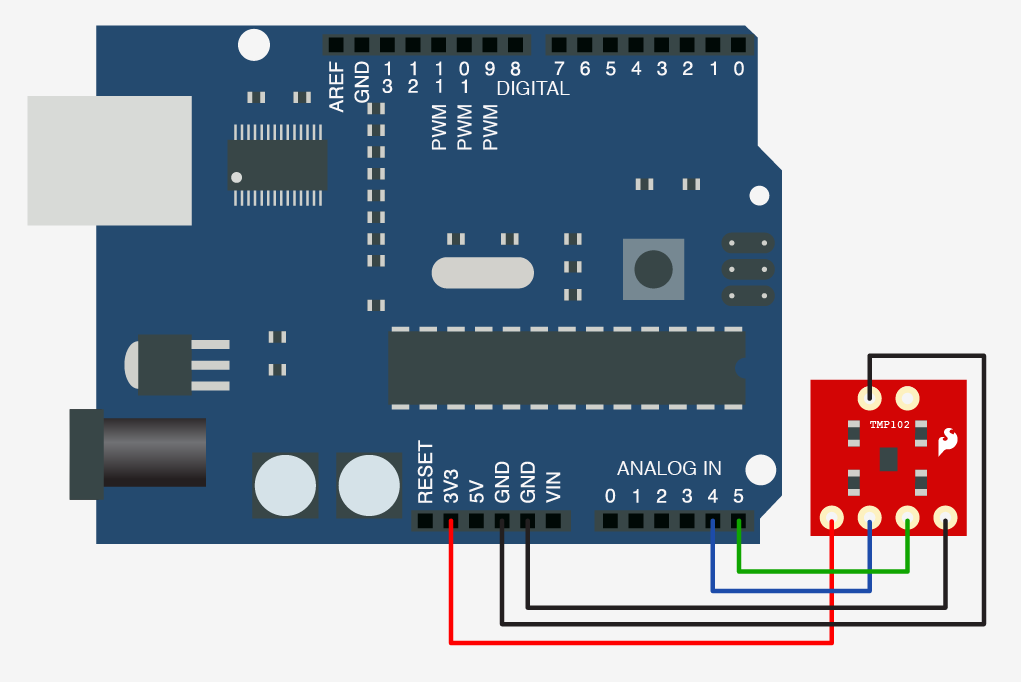| |
Temperature Sensor
Description: Measuring Temperature using the TMP102Tutorial Level: BEGINNER
Next Tutorial: Push Button
Show EOL distros:
In this tutorial, we will use an Arduino and a TMP102 temperature sensor to measure the ambient temperature in a room. The tutorial's goals are two fold. The first is to show an example temperature sensing node. The second is to demonstrate the Arduino as an I2C interface for ROS. The TMP102 is one of many pieces of hardware that use I2C to communicate. You can now interface SPI/I2C to ROS with ease using an Arduino.
Hardware
For this tutorial, you will need an Arduino and a TMP102 Breakout board from Sparkfun. This board is a great little temperature sensor that can measure temperature with a 0.625 degree C resolution. Connecting it to an Arduino is very straightforward. It is a 3.3V sensor communication over I2C so it connects to the Arduino's 3.3V output, GND, SDA, SCL pins. SDA and SCL are the I2C data line and I2C clock line respectively. They are exposed on the Arduino board as analog pins 4 and 5.

Diagram from here
Code
1 #include <Wire.h>
2 #include <ros.h>
3 #include <std_msgs/Float32.h>
4
5
6 //Set up the ros node and publisher
7 std_msgs::Float32 temp_msg;
8 ros::Publisher pub_temp("temperature", &temp_msg);
9 ros::NodeHandle nh;
10
11 int sensorAddress = 0x91 >> 1; // From datasheet sensor address is 0x91
12 // shift the address 1 bit right,
13 //the Wire library only needs the 7
14 // most significant bits for the address
15
16 void setup()
17 {
18 Wire.begin(); // join i2c bus (address optional for master)
19
20 nh.initNode();
21 nh.advertise(pub_temp);
22
23 }
24
25 long publisher_timer;
26
27 void loop()
28 {
29
30 if (millis() > publisher_timer) {
31 // step 1: request reading from sensor
32 Wire.requestFrom(sensorAddress,2);
33 delay(10);
34 if (2 <= Wire.available()) // if two bytes were received
35 {
36 byte msb;
37 byte lsb;
38 int temperature;
39
40 msb = Wire.read(); // receive high byte (full degrees)
41 lsb = Wire.read(); // receive low byte (fraction degrees)
42 temperature = ((msb) << 4); // MSB
43 temperature |= (lsb >> 4); // LSB
44
45 temp_msg.data = temperature*0.0625;
46 pub_temp.publish(&temp_msg);
47 }
48
49 publisher_timer = millis() + 1000; //publish once a second
50 }
51
52 nh.spinOnce();
53 }
The special bit of code in this example is the use of Arduino's Wire library. Wire is a I2C library that simplifies reading and writing to the I2C bus.
Testing
roscore
rosrun rosserial_python serial_node.py _port:=/dev/ttyUSB0
rosrun rosserial_python serial_node.py /dev/ttyUSB0
rostopic echo temperature







